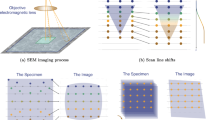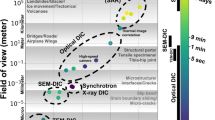Abstract
Recently, scanning electron microscopy (SEM) has been used for digital image correlation (DIC), as micrographs can be acquired with high magnification, providing improved resolution to quantify strain heterogeneities. However, it has been shown by researchers that SEM images can be problematic due to inherent electromagnetic distortions that are not present in optical images. Drift, spatial distortions, and magnification uncertainties are the main issues that can seriously affect the accuracy of localized strain measurements. The present work focuses on long duration experiments, for which images are taken days or weeks apart. We have proposed a systematic procedure to reduce drift, correct spatial distortion, and account for magnification variations between pairs of acquired images. Additionally, SEM parameters are discussed and chosen to increase the signal-to-noise ratio and improve the accuracy of the DIC measurements. The spatial distortion correction increases the repeatability of the correlated values and the precision of the measurements. The implementation for this type of correction is done by applying the measured distortion gradient of a certified grid onto the DIC strain field. The magnification adjustment increases the reliability of the strain maps, ensuring the measurements are in agreement with the actual strain induced during the experiment. We have presented a systematic protocol for ex-situ DIC experiments within the SEM and some basic cross-check procedures that can be performed to evaluate the reliability of the reference grid and the precision of the final strain map.



















Similar content being viewed by others
References
Efstathiou C, Sehitoglu H, Lambros J (2010) Multiscale strain measurements of plastically deforming polycrystalline titanium: role of deformation heterogeneities. Int J Plast 26(2010):93–106. doi:10.1016/j.ijplas.2009.04.006
Abuzaid WZ, Sangid MD, Carroll JD, Sehitoglu H, Lambros J (2012) Slip transfer and plastic strain accumulation across grain boundaries in Hastelloy X. J Mech Phys Solids 60(6):1201–1220
Tschopp MA, Bartha BB, Porter WJ, Murray PT, Fairchild SB (2009) Microstructure-Dependent Local Strain Behavior in Polycrystals through In-Situ Scanning Electron Microscope Tensile Experiments. Metall Mater Trans A: Phys Metall Mater Sci 40(10):2363–2368. doi:10.1007/s11661-009-9938-6
Carter JLW, Zhou N, Sosa JM, Shade PA, Pilchak AL, Kuper WM, Wang Y, Fraser HL, Uchic MD, Mills MJ (2012) Characterization of strain accumulation at grain boundaries of nickel based superalloys. Superalloys 2012: 12th International Symposium on Superalloys (TMS), pp 43–52. doi:10.1002/9781118516430.ch5
Di Gioacchino F, Quinta da Fonseca J (2013) Plastic Strain Mapping with Sub-Micron Resolution Using Digital Image Correlation. Exp Mech 53(5):743–754. doi:10.1007/s11340-012-9685-2
Esquivel J, Sangid MD (2015) Digital Image Correlation of Heterogeneous Deformation in Polycrystalline Material with Electron Backscatter Diffraction. Microsc. Microanal. 21 (Suppl 3), 21 (0583): 1167–68. doi:10.1017/S1431927615006625
Kammers A, Daly S (2011) Experimental investigation of deformation mechanisms present in ultrafine-grained metals. In: Proulx T (ed) MEMS and nanotechnology, Volume 44. Conference Proceedings of the Society for Experimental Mechanics Series. Springer, New York, pp 105–10. doi:10.1007/978-1-4614-0210-7
Sutton MA, Li N, Garcia D, Cornille N, Orteu JJ, McNeill SR, Schreier HW, Li X, Reynolds AP (2007) Scanning Electron Microscopy for Quantitative Small and Large Deformation Measurements Part II: Experimental Validation for Magnifications from 200 to 10,000. Exp Mech 47(6):789–804. doi:10.1007/s11340-007-9041-0
Sutton MA, Li N, Joy DC, Reynolds AP, Li X (2007) Scanning Electron Microscopy for Quantitative Small and Large Deformation Measurements Part I: SEM Imaging at Magnifications from 200 to 10,000. Exp Mech 47(6):775–787. doi:10.1007/s11340-007-9042-z
Sutton MA, Li N, Garcia D, Cornille N, Orteu JJ, McNeill SR, Schreier HW, Li X (2006) Metrology in a Scanning Electron Microscope: Theoretical Developments and Experimental Validation. Meas Sci Technol 17(10):2613. doi:10.1088/0957-0233/17/10/012
Hitachi High-Technologies Corporation (2013) Ultra-high Resolution Scanning Electron Microscope SU8200 Series. Main specifications. www.hitachi-hitec.com/global/em/. Tokyo
Kammers AD, Daly S (2013) Self-Assembled Nanoparticle Surface Patterning for Improved Digital Image Correlation in a Scanning Electron Microscope. Experimental Mechanics, 1–15. doi:10.1007/s11340-013-9734-5.
Kammers AD, Daly S (2013) Digital image correlation under scanning electron microscopy: methodology and validation. Exp Mech 53.9:1743–1761
Stinville JC, Vanderesse N, Bridier F, Bocher P, Pollock TM (2015) High Resolution Mapping of Strain Localization near Twin Boundaries in a Nickel-Based Superalloy. Acta Mater 98:29–42. doi:10.1016/j.actamat.2015.07.016
Dai X, Xie H (2013) High-accuracy magnification calibration for a microscope based on an improved discrete Fourier transform. Opt Eng 52(11):1328–1342. doi:10.1117/1.OE.52.11.114102
Tortonese M, Guan Y, Prochazka J (2003) NIST-traceable calibration of CD-SEM magnification using a 100-nm pitch standard. Proc SPIE - Int Soc Opt Eng 5038:711–718. doi:10.1117/12.482648
Vladar AE (1999) Time-Lapse Scanning Electron Microscopy for Measurement of Contamination Rate and Stage Drift. Scanning 21:191–196
Stinville JC, Echlin MP, Texier D, Bridier F, Bocher P, Pollock TM (2016) Sub-Grain Scale Digital Image Correlation by Electron Microscopy for Polycrystalline Materials during Elastic and Plastic Deformation. Exp Mech 56(2):197–216. doi:10.1007/s11340-015-0083-4
Marschallinger R, Topa D (1997) Assessment and Correction of Geometric Distortions in Low-Magnification Scanning Electron Microscopy Images. Scanning 19:36–41
Charbal A, Dufour J-E, Guery A, Hild F, Roux S, Vincent L, Poncelet M (2016) Integrated Digital Image Correlation considering gray level and blur variations: Application to distortion measurements of IR camera. Opt Lasers Eng 78:75–85. doi:10.1016/j.optlaseng.2015.09.011
Watt IM (1997) The Principles and Practice of Electron Microscopy. Chapter 5. 189-200. Second Edition. Cambridge University Press. ISBN 0 521 43591 9. New York
Book TA, Sangid MD (2016) Strain Localization in Ti-6Al-4V Widmanstätten Microstructures Produced by Additive Manufacturing. Mater Charact 122:104–112. doi:10.1016/j.matchar.2016.10.018
Mello AW, Nicolas A, Sangid MD (2017) Fatigue strain mapping via digital image correlation for Ni-based superalloys: the role of thermal activation on cube slip. Mater Sci Eng A 695:332–341. doi:10.1016/j.msea.2017.04.002
Acknowledgements
Support for this work was provided by Rolls-Royce Corporation, DARPA (N66001-14-1-4041), the National Science Foundation (CMMI 13-34664), and the Office of Naval Research, (N00014-14-1-0544). The authors would like to thank: John Rotella from Purdue’s ACME2 group for his help on processing the images; Jan Eberle from Purdue for his help in better understanding the principles of SEM; and Professor Samantha Daly from the University of California at Santa Barbara for discussions on this topic. All electron microscopy was performed with the help of staff in the Life Science Microscopy Facility, Purdue University.
Author information
Authors and Affiliations
Corresponding author
Appendix
Appendix
This paper provides a systematical protocol for distortion corrections (due to inherent electromagnetic spatial distortion or inaccurate displayed magnification values). The aforementioned procedures were developed for long duration, ex-situ experiments, in which the referenced and strained images are taken in separate SEM sessions and to minimize spatial distortion in SEM systems in which the xyz translational position stage has low resolution. To ensure this procedure is repeatable and easy to implement by future users, Table 1 provides a concise summary of the distortion correction protocol.
Rights and permissions
About this article
Cite this article
Mello, A.W., Book, T.A., Nicolas, A. et al. Distortion Correction Protocol for Digital Image Correlation after Scanning Electron Microscopy: Emphasis on Long Duration and Ex-Situ Experiments. Exp Mech 57, 1395–1409 (2017). https://doi.org/10.1007/s11340-017-0303-1
Received:
Accepted:
Published:
Issue Date:
DOI: https://doi.org/10.1007/s11340-017-0303-1




